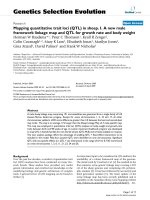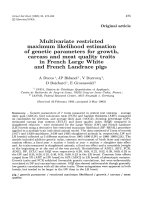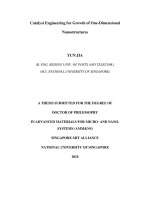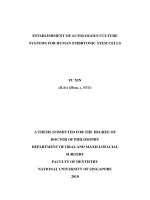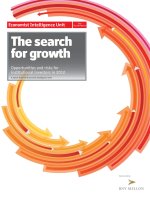Screening of suitable culture media for growth, cultural and morphological characters of pycnidia forming fungi
Bạn đang xem bản rút gọn của tài liệu. Xem và tải ngay bản đầy đủ của tài liệu tại đây (462.54 KB, 8 trang )
Int.J.Curr.Microbiol.App.Sci (2018) 7(8): 4207-4214
International Journal of Current Microbiology and Applied Sciences
ISSN: 2319-7706 Volume 7 Number 08 (2018)
Journal homepage:
Original Research Article
/>
Screening of Suitable Culture Media for Growth, Cultural and
Morphological Characters of Pycnidia Forming Fungi
K. Sarda Devi1*, Dilip Kumar Misra2, Jayanta Saha2,
Ph. Sobita Devi1 and Bireswar Sinha1
1
Department of plant pathology, College of Agriculture, CAU, Iroisemba, Imphal,
Manipur, India
2
Department of plant pathology, Faculty of Agriculture, BCKVV, Mohanpur, Nadia,
W.B., India
*Corresponding author
ABSTRACT
Keywords
Pycnidia forming Fungi,
Culture media, Synthetic
media, semi-synthetic,
Colony character
Article Info
Accepted:
22 July 2018
Available Online:
10 August 2018
Different agar media, including natural, Oat Meal Agar (OMA), Malt Extract Agar
(MEA), V8 Agar and Leaf extract agar of host plant, semi-synthetic media, Potato
Dextrose Agar (PDA), carrot dextrose agar (CaDA) and synthetic media, Czapex Dox
Agar (CDA), Richards Synthetic Agar (RSA), Asthana and Hawkers Agar (AHA)) were
used to observed the mycelial growth rate, cultural and morphological characters of four
fungal isolates after seven days of incubation at 26±1°C. The colony character including
diameter, culture characteristics (texture, surface and reverse colouration, zonation) and
sporulation of selected test fungi were greatly influenced by the type of growth medium
used. On comparative study of higher mycelial growth of the four test fungi, the best
performance where observed in PDA as well as moderate to heavy sporulation on this
culture medium. These results will find use in fungal taxonomic studies.
Introduction
There are two million kinds of living
organisms on the earth, of which fungi
constitute approximately a hundred thousand
species, and many more await discovery. No
matter which aspect of fungi we look at, they
are highly diverse and versatile organisms
adapted to all kinds of environments and
require several specific elements for growth
and reproduction. Fungi are isolated on
specific culture medium for cultivation,
preservation, microscopic examination and
biochemical
and
physiological
characterization. A wide range of media are
used for isolation of different groups of fungi
that influences the vegetative growth and
colony morphology, pigmentation and
sporulation depending upon the composition
of specific culture medium, pH, temperature,
light, water availability and surrounding
atmospheric gas mixture (Northolt and
Bullerman, 1982; Kuhn and Ghannoum, 2003;
Kumara and Rawal, 2008). However, the
requirements for fungal growth are generally
less stringent than for the sporulation.
Nowadays, fungal taxonomy is in a state of
rapid flux, because of the recent researches
4207
Int.J.Curr.Microbiol.App.Sci (2018) 7(8): 4207-4214
based on molecular approaches, that is DNA
comparisons of selected strains either isolated
locally or obtained from culture collection
centre, which has changed the existing
scenario of fungal systematic and often
overturn the assumptions of the older
classification systems (Hibbett, 2006).
Different concepts have been used by the
mycologists to characterize the fungal species,
out of which morphological and reproductive
stages are the classic approaches and baseline
of fungal taxonomy and nomenclature that are
still valid (Davis, 1995; Guarro et al., 1999;
Diba et al., 2007; Zain et al., 2009). It seems
evident that in near future, modern molecular
techniques will allow most of the
pathogenicand opportunistic fungi to be
connected to their corresponding sexual stages
and integrated into a more natural taxonomic
scheme. Physical and chemical factors have a
pronounced effect on diagnostic characters of
fungi. Hence, it is often necessary to use
several media while attempting to identify a
fungus in culture since mycelial growth and
sporulation on artificial media are important
biological characteristics (St-Germain and
Summer bell, 1996). Furthermore, findings for
one species are not readily extrapolated to
others, where significant morphological and
physiological variations exist (Meletiadis et
al., 2001). With these perspectives, the present
study was undertaken to observe the influence
of nine different culture media on the mycelial
growth, colony characters and sporulation
patterns of four pycnidia producing
phytopathogenic fungi.
Materials and Methods
Collection of disease samples
Collection of disease samples were done from
Jaguli instructional farm, Mohanpur, (located
at 22°43' N latitude and 88°34' E longitude
with an elevation of 9.75 m above mean sea
level) from Research farm of B.C.K.V.,
Mundouri, Nadia, West Bengal and also from
‘C’ block farm, BCKV, Kalyani Nadia, West
Bengal.
Plants under study
The different crops used for the experiment
includes:
Vegetable, Brinjal (Solanum melongena),
Flower, Tuberose (Polianthes tuberosa),
Medicinal, Mesta (Hibiscus sabdariffa),
Fruit, Jackfruit (Artocarpus heterophyllus)
The media
Different
laboratory
media
including
synthetic,
semi-synthetic
and
natural
mediawere used for isolation and maintenance
of the pathogen. Different agar media, viz.,
Czapex Dox Agar (CDA), Richards Synthetic
Agar (RSA), Asthana and Hawkers Agar
(AHA), Potato Dextrose Agar (PDA), Oat
Meal Agar (OMA), Malt Extract Agar (MEA),
V8Agar, Leaf extract agar of the host plant.
Isolation of phytopathogenic fungi
Parts of diseased plants showing typical
symptoms of the disease were collected from
university experimental field. The diseased
parts were made small pieces; surface
sterilized with 0.1% mercuric chloride (HgCl2)
solution for 30-45 seconds followed by 5-6
times washing with sterilized distilled water.
Thereafter, excess water on diseased parts was
removed with sterilized blotting paper.
Sterilized molten water agar medium of
approximately 20 ml having temperature
around 45 0C was poured into each sterilized
(in hot air oven at 160 0C for 2 hours) Petriplate, allowed to cool down and solidify. Then
the surface sterilized diseased plant pieces (3
pieces per Petri dish) were transferred on to
the solidified water agar medium in sterilized
Petri plates. The Petri plates were incubated in
4208
Int.J.Curr.Microbiol.App.Sci (2018) 7(8): 4207-4214
BOD at 28±1 0C temperature and observed
periodically for the growth of fungus. When
fungus just grows approximately 1.5-2.0 cm
diameter then bits of fungal growth from such
area ware transferred to PDA slants and
incubated in BOD at 28 ±10C for few days.
Then such pure cultured slants were preserved
in a refrigerator at 5 0C for further studies and
renewed once within 2-3 months. Phoma
sabdarifa, Phoma polyanthes, Phomopsis
vexans and Phyllosticta artocarpina were used
from its pure cultures and 5 mm discs of each
fungus were transferred at the centre of sterile
Petri dishes (in triplicates) containing nine
different growth media that includes natural
(oat meal agar OMA, malt extract agar MEA,
V8A, and leaf extract agar LEA), semisynthetic (potato dextrose agar PDA, carrot
agar media CaDA) and synthetic media
(czapek’s dox CDA, Asthana and Hawkers
agar AHA and Richard synthetic media
(RSA).
Results and Discussion
All nine culture media supported the growth
of test fungi to various degrees. Out of the
four fungi, three fungi showed maximum
mycelial growth on PDA and CaDA after 7
days of incubation period (Table 1), while
Phyllosticta artocarpina showed maximum
growth on LEA after 72 hrs (21.0 mm)
whereas Phoma sabdariffa, Phomopsis vexans
showed higher colony growth on PDA with
50.3mm, 61mm and Phoma polyanthes
showed higher mycelial growth in CaDA of
78.9 mm and in PDA of 75.7mm respectively
at 72 hrs.
In the present study, mycelial growth,
pigmentation and zonations observed in fungal
colonies were found to be influenced by the
culture media used. In PDA, almost all tested
fungi were characterized with regular mycelial
growth and distinct circular zonations whereas
in synthetic media comparatively lower
mycelial growth is observed. In PDA, Phoma
sabdariffa showed slightly fluffy mycelial
growth with zonations, Phomopsis vexans
showed
good mycelial
growth and
pigmentation on the reverse side in PDA and
thin mycelial growth with no zonation in case
of synthetic media.
In case of Phoma polyanthes, fluffy thick
mycelial growth were observed in PDA and
semi synthetic media with dark pigmentation
on the reverse side of the plate whereas lesser
mycelial growth and lighter pigmentation in
case of synthetic media except Phyllosticta
artocarpina showed maximum mycelial
growth in LEA, lesser in semi synthetic
media, and least being in synthetic media.
PDA is one of the most commonly used
culture media because of its simple
formulation and its ability to support mycelial
growth of a wide range of fungi. Several
workers stated PDA to be the best media for
mycelial growth (Xu et al., 1984; Maheshwari
et al., 1999; Saha et al., 2008). Most fungi
thrive on PDA, but this can be too rich in
nutrients, thus encouraging the mycelial
growth with ultimate loss of sporulation
(UKNCC, 1998).
Our findings revealed the influence of culture
media on the growth, colony character and
sporulation of the test fungi differs based on
the nature of the culture medium. Out of the
nine media studied, OMA and MEA was
found to be suitable for heavy sporulation
while PDA reproduced most visible colony
morphology.
From the investigation it can also be
concluded that instead of using any single
culture medium a combination of two or more
media will be more appropriate for routine
cultural and morphological characterization of
fungi to observe different colony features and
their responses (Fig. 1).
4209
Int.J.Curr.Microbiol.App.Sci (2018) 7(8): 4207-4214
The compositions of different media used in the investigationare presented below:
a. Potato Dextrose Agar
Peeled potato (decoction) 200g
Dextrose anhydrous 20g
Agar agar 20g
Distilled water1000ml
d. Czapek’s Dox Agar
Sucrose 30g
Sodium nitrate 2g
Dipotassium hydrogen phosphate
1g
Magnesium sulphate, 7 H2O 0.5g
Potassium chloride 0.5g
Ferrous sulphate, 7 H2O 0.01g
Agar agar 20g
Distilled water 1000ml
g. Carrot Dextrose agar
Peeled and sliced carrot
200.00 g
Agar-agar 20.00 g
Distilled water 1000 ml
b. Oatmeal Agar
White oat (decoction) 40g
Agar agar 20g
Distilled water 1000ml
c. Malt Extract Agar
Malt extract 20g
Agar agar 15g
Distilled water 1000ml
e. Richard’s Synthetic Agar
Sucrose 50g
Potassium nitrate 10g
Potassium hydrogen phosphate 5g
Magnesium sulphate, 7 H2O 2.5g
Ferric chloride 0.02g
Agar agar 20g
Distilled water 1000ml
f. Asthana and Hawker’s
agar
Glucose 5 gm
KNO3 3.5 gm
MgSO4, 7H2O 0.75 gm
KH2PO4 1.75 gm
Distilled water 1000 m
Agar agar20 gm
h. V8 agar media
44.3 gm of V8 agar is dissolved in
1000 ml of distilled water andboiled
to dissolve followed by sterilization
in 15 psi at 161 degrees temperature
for 15 degrees.
i. Host Leaf Decoction Agar
Chopped leaf (decoction) 150g
Agar agar 20g
Distilled water1000ml
Table.1 Mycelia growth, colony characters and sporulation pattern of fungal isolates on nine
culture media
Medium
Colony diameter
(mm) in 72 hrs for
Phoma sabdariffa
Colony character
PDA
50.3
CaDA
42
OMA
40
Thin
slightly
fluffy
Thin
slightly
fluffy
Fluffy
MEA
42
V8A
41.3
LEA
38.2
AHA
20
RSA
10
CDA
8.7
Thin non
Fluffy
Thick
compact
Thin
growth
Thin
growth
Thin
growth
Thin
growth
Texture
Reverse
Colour
Zonation
Sporulation
Whitish grey
Colourless
Concentric zones
Moderate
Whitish grey
Colourless
Concentric
Zones
poor
Whitish grey
Colourless
moderate
Whitish grey
Colourless
Whitish grey
Colourless
Irregular
concentric zones
Irregular
concentric zones
Concentric zones
Whitish grey
Colourless
None
moderate
Translucent
Colourless
None
poor
Translucent
Colourless
None
poor
Translucent
Colourless
None
poor
Surface
Colour
4210
heavy
poor
Int.J.Curr.Microbiol.App.Sci (2018) 7(8): 4207-4214
Medium
Colony diameter
(mm) in 72 hrs for
Phomopsis vexans
Colony character
Texture
Surface
Colour
Thick fluffy Off white to
crust
light brown
Thick fluffy Pale white
crust
coloured to
light brown
Flat
White to
suppressed
light brown
mycelium
Fluffy
Pale white
cottony
coloured
growth
Fluffy
Light brown
cottony
Reverse
Colour
Zonation
Sporulation
PDA
61
Light lemon
yellow
Deep yellow to
brown
Concentric zones
moderate
CaDA
48
none
moderate
OMA
33.3
Deep yellow to
brown
none
heavy
MEA
35
Deep brown
concentric
irregular zones
V8A
31
Deep brown
Concentric
irregular zones
moderate
LEA
20
Grey white
Colourless
Concentric zones
poor
Pale white
poor
None
poor
20.6
Thin growth
Translucent
Light Lemon
yellow
Light Lemon
yellow
Colourless
None
38.3
Thin flat
growth
Thin
flat
growth
Thin growth
AHA
34.6
RSA
CDA
None
poor
Reverse
Colour
Zonation
Sporulation
Uniform black
colour
Uniform black
colour
Concentric zones
moderate
None
moderate
Translucent
Medium
Colony diameter
(mm) in 72 hrs for
Phoma polyanthis
PDA
75.7
Colony character
Texture Surface
Colour
fluffy
Light grey
CaDA
78.9
fluffy
Light grey
OMA
78.3
Fluffy
greyish
Uniform black
colour
concentric zones
moderate
MEA
56.3
Fluffy
Whitish grey
Uniform black
colour
concentric zones
heavy
V8A
64
Thin
growth
Deep grey
Uniform black
colour
Concentric zones
poor
LEA
45
Whitish grey
moderate
56.3
Uniform
lighter
coloured
Uniform light
coloured
Concentric zones
AHA
Thin
irregular
growth
Thin
growth
None
Poor
RSA
63
Thin
growth
Greyish
Uniform dark
pigmentation
None
poor
CDA
60.3
Thin
growth
Greyish
Uniform dark
pigmentation
None
poor
greyish
4211
Int.J.Curr.Microbiol.App.Sci (2018) 7(8): 4207-4214
Medium Colony diameter
Colony character
(mm) in 72 hrs for
Phyllosticta artocarpina
Texture
Surface
Colour
Reverse Colour Zonation Sporulation
PDA
12.7
Irregularly
formed
Hard
mycelium
light
greyish
Uniform black
pigmentation
none
moderate
CaDA
11.5
Hard
mycelium
Deep
black
Uniform black
pigmentation
none
moderate
OMA
8
Hard
mycelium
Whitish
grey
Uniform black
pigmentation
none
high
MEA
7.8
Hard
mycelium
Whitish
grey
Uniform black
pigmentation
V8A
9
Hard thin Whitish
mycelium
grey to
dirty grey
Yellowish
pigmentation
Concent
ric
zones
poor
LEA
21
Hard
mycelium
Deep
black
Uniform black
pigmentation
None
moderate
AHA
7.2
Hard
mycelium
Greyish to
dark grey
Uniform black
pigmentation
None
poor
RSA
7.5
Hard
mycelium
Whitish
grey
Uniform dark
pigmentation
None
poor
Pycnidia and Spores of the four test fungi
4212
moderate
Int.J.Curr.Microbiol.App.Sci (2018) 7(8): 4207-4214
Fig.1 Colony growth, colour and pycnidia with spores of the test fungi on different culture agar
media (PDA; CaDA, OMA, MEA, V8A, LEA, AHA, RSA, CDA)
Phomopsis vexans
Phoma sabdariffaPhyllosticta artocarpina Phoma polyanthis
Phoma sabdariffa
Phoma polyanthi
Phyllosticta artocarpina
Phomopsis vexans
Acknowledgements
References
Authors are grateful to Department of Plant
pathology, Faculty of Agriculture, BCKVV,
Mohanpur, WB.
Davis JI (1995). Species concepts and
phylogenetic
analysis.Introduction.
Syst. Bot., 20: 555-559.
4213
Int.J.Curr.Microbiol.App.Sci (2018) 7(8): 4207-4214
Diba K, Kordbacheh P, Mirhendi SH, Rezaie
S, Mahmoudi M (2007). Identification
of
Aspergillus
species
using
morphological characteristics. Pak. J.
Med. Sci., 23(6): 867-872.
Guarro J, Josepa G, Stchigel AM (1999).
Developments in Fungal Taxonomy.
Clin. Microbiol. Rev., 12: 454-500.
Hibbett DS (2006). A phylogenetic overview
of the Agaricomycotina. Mycologia,
98(6): 917-925.
Kuhn DM, Ghonnoum MA (2003). Indoor
mold, toxigenic fungi, and Stachybotrys
chartarum:
Infectious
disease
perspective. Clin. Microbiol. Rev.,
16(1): 144-172.
Kumara KLW, Rawal RD (2008). Influence
of carbon, nitrogen temperature and pH
on the growth and sporulation of some
Indian isolates of Colletotrichum
gloeosporioides causing anthracnose
disease of papaya (Carrica papaya L).
Trop. Agric. Res. Ext., 11: 7-12.
Maheshwari SK, Singh DV, Sahu AK (1999).
Effect of several nutrient media, pH and
carbon sources on growth and
sporulation of Alternaria alternata. J.
Mycopathol. Res. 37: 21-23.
Meletiadis J, Meis JFGM, Mouton JW,
Verweij PE (2001). Analysis of growth
characteristics of filamentous fungi in
different nutrient media. J. Clin.
Microbiol., 39(2): 478-484.
Northolt MD, Bullerman LB (1982).
Prevention of mold growth and toxin
production
through
control
of
environmental condition. J. Food Prot.,
6: 519-526.
Saha A, Mandal P, Dasgupta S, Saha D
(2008). Influence of culture media and
environmental factors on mycelial
growth and sporulation of Lasiodiplodia
theobromae (Pat.) Griffon and Maubl. J.
Environ. Biol., 29(3): 407-410.
St-Germain G, Summerbell R (1996).
Identifying Filamentous Fungi – A
Clinical Laboratory Handbook, 1st Ed.
Star
Publishing
Co.,
Belmont,
California.
UKNCC (1998). Growth and Media Manuals.
Strain databases (www.ukncc.co.uk/)
Xu SO, Yuan SZ, Chen XC (1984). Studies
on pathogenic fungus (Alternaria
tennuis Nees) of poplarleaf blight. J.
North East For. Inst., 12: 56-64.
Zain ME, Razak AA, El-Sheikh HH, Soliman
HG, Khalil AM (2009).Influence of
growth
medium
on
diagnostic
characters
of
Aspergillus
and
Penicillium species Afr. J. Microbiol.
Res., 3(5): 280-286.
How to cite this article:
Sarda Devi, K., Dilip Kumar Misra, Jayanta Saha, Ph. Sobita Devi and Bireswar Sinha. 2018.
Screening of Suitable Culture Media for Growth, Cultural and Morphological Characters of
Pycnidia Forming Fungi. Int.J.Curr.Microbiol.App.Sci. 7(08): 4207-4214.
doi: />
4214

